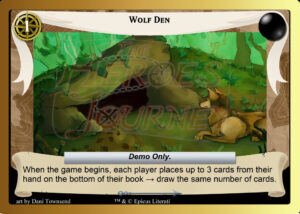“Now we must go back to the first tale.” -the Jungle Book
It is always a challenge to bring people into a new game. Part of why we loved The Heroes’ Journey and enjoy making it, is that it is not as complicated a game as it first seems. The biggest hurdle we’ve noticed in demonstrations is getting people to understand the dichotomy that is the core of the game’s nature. However we don’t want to trim out the strategy and depth of our initial products, making them boring and uninteresting on repeat plays.
So we decided to make a simpler, streamlined product that could act as an introduction to the game’s fundamental basics. An intro product for players to help them get used to how things work.
Still we needed a theme as well. It wouldn’t do to have a cliché hero fighting against cliché villains. We like our game to be filled with tributes and adaptions of modern as well as classic stories. Could we find a story out there which would give us enough material to make this deck, but not so much it would feel like we were cheating our players by leaving out so much more.
Enter Rudyard Kipling to our rescue.
Published in 1894, The Jungle Book is not so much a single story, but an anthology collection of tales. While most of them are disconnected from one another, there are three tales which tell of the adventures of a young boy raised by the jungle, Mowgli. (And it would be these tales Disney would later adapt into its animated motion picture.)
Like episodes of an old movie serial, his adventures are fairly short, almost always involve a journey, and has a colorful cast of characters. In short: this classic was a perfect fit for our needs.
So we had the concept and we had the source. Now we had to figure out the rules. Intro games are supposed to be shorter than the full experience. If we kept to our goal of keeping the intro deck as half the size of a normal one, players would find a full game boring as they run out of cards halfway through. The solution seemed obvious: just make the game half the size. Instead of reaching site 9, just have Mowgli journey to site 5 or 6.
We considered that, but didn’t like it. As game-makers, we have made a promise to ourselves to never sell a product that couldn’t be played with the rest. We never want to sell you cards that are automatic binder-fodder. We debated whether there should just be rules talking about a demo game being shorter or stick with our philosophy of putting as much on the cards as we can. Yet if the game text on the cards forced the game to end sooner than usual, wouldn’t that tempt competitive players to always run this design?
Eventually, we figured it out: 2 sided cards.

 Here you can see Mowgli himself and the Quest-need he will be using. When learning the game and playing the intro deck against another intro deck, you’ll be using the “Demo Only.” side of Mowgli’s Quest-need (Man’s Red Flower). Notice it has a bit of skirmish text and the demo version of victory: survive to site 6.
Here you can see Mowgli himself and the Quest-need he will be using. When learning the game and playing the intro deck against another intro deck, you’ll be using the “Demo Only.” side of Mowgli’s Quest-need (Man’s Red Flower). Notice it has a bit of skirmish text and the demo version of victory: survive to site 6.
Now when you are ready to bring Mowgli to a full, regular game or a tournament, you’ll need to flip his Quest-Need over…
Click here to see the other side of Man's Red Flower
On the other side, we can see the Quest Need looks a little more familiar. It has the standard class on it and a party limit. Finally to stand among the greatest heroes, Mowgli must must overcome the full journey requirement of overcoming the physical and spiritual challenges along the way and reach site 9.
Once we had this idea we found it also provided the solution to our challenge with sites. To further simplify the game and make the experience of it faster, we designed one side of the sites to be what we call “fixed” format. Rather than bogging down rookies with tactical decisions they can’t fully grasp yet, the sites are pre-numbered. Since most demo games (for now) will involve decks using the same sites, this also helped us customize the play experience for new players. Thus instead of trying to explain the rules for a mulligan, the site 1 demo version of “Wolf Den” spells out a simplified version. When players’ decks are starting to run out, site 5 gives them a “reload” so the game can be exciting all the way to the end.
Since sites’ terrain isn’t being used in the demo game, the terrain box on each site was thus marked “Demo Only.”
As sites are an important, tactical decision in the regular game, we couldn’t leave Mowgli and his friends at a disadvantage when confronting the wider world. So like the QN, when you are ready for a greater challenge, just flip the sites over.
Next week, we’ll reveal and go over the Campaign side of the intro.
You can pick up a copy of the intro deck to get your journey started at our store page.













2 thoughts on “Welcome to the Jungle – Creating the intro deck”
Comments are closed.